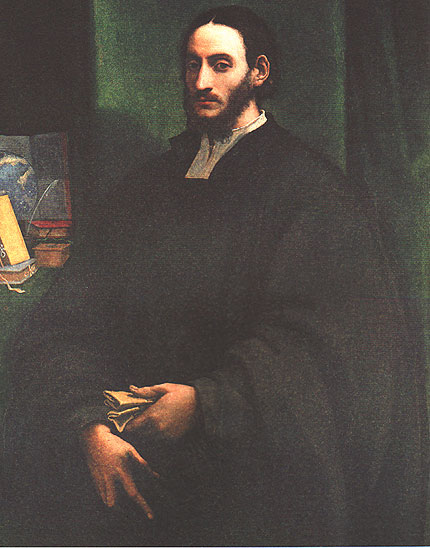Al Hassan Ibn Muhammad Al Wazzan Al Fasi الحسن بن محمد الوزان الفاسي, also known as Leo Africanus ليو الأفريقي, is one enigmatic figure in 16th century Europe.

Born in Muslim Spanish city of Granada around 1494, he soon moved to Fez, Morocco shortly afterwards, most likely due to the harsh policies of the new Christians kings. He got good education, and graduated as a legal scholar (Faqih). He then briefly worked in a Maristan (hospital and asylum). He accompanied an uncle on a diplomatic mission south in Western Africa (Timbuktu, Songhay, Kano, and others). This trip was important since he recorded the details in his Description of Africa. Later, he traveled to Egypt, Constantinople, and probably Arabia.
Upon his return trip in 1518 by sea, the ship he was in was captured by pirates near the island of Jerba. He was taken first to Rhodes (head quarters for the Knights of St. John), and then finally to Pope Leo X. The Pope, a man of learning, was impressed with his intelligence, and capabilities. He was converted to Christianity in 1520, and was freed from slavery, and named Johannes Leo (or other variations depending on the language/dialect: Jean Leon, Giovanni Leone de Medicis, or Leo The African, hence Leo Africanus). In 1521, he lost his mentor, Pope Leo X who died that year. He then moved to Bologna upon the accession to the Papacy by Hadrian VI. He later returned to Rome, after visiting Naples and Florence as well.
Leo wrote his travels in his Description of Africa, and also wrote an Arabic-Latin-Hebrew vocabulary. He also taught Arabic to various pupils in the papal court. His students include the Poet made Cardinal by the Pope: Egidio Antonini of Viterbo (1465–1532), who in turn taught the German Orientalist Johann Albrecht von Widmanstetter (1506–1557).
Leo was assisted in translation, and in writing the manuscript of Description of Africa by another native Arabic speaker, Elia Ben Abraham Maronita, a Lebanese Friar in Rome.
Not much is known about Leo's later life. The most accepted version is that he left Rome and made his way back to Tunisia prior to the sack of Rome in May 1527 by the Imperial troops. There, he reverted back to Islam, and died in relative anonymity around 1550. Some say he made his way to Morocco from Tunis and died there instead.
Before Leo's Description of Africa was published, Guillaume Postel (1510-1581), a French Orientalist who travelled to East in search of manuscripts, and made marginal notes in Latin on many Arabic manuscripts now in Europe, made use of it to enhance his map of Kano (northern Nigeria).
Just like Al Idrisi before him, and Joseph Barbatus after him, Leo became one became one of many links from Arabic knowledge of the Islamic civilization in the East and Renaissance Europe in the West.
Works
- Della descrittione dell'Africa et delle cose notabli che ivi sono. Description of Africa, his magnum opus.
- De viris quibusdam illustribus apud Arabes. Biographies of of 30 famous persons from Arab history. 25 are Muslims, and 5 are Jewish.
- An Arabic-Hebrew-Latin vocabulary, wrote for a Jewish Physician of Andalusian origins, Jacob Ibn Simeon (Jacob Mantino). This work is often characterized as a medical vocabulary in the three languagues. However, looking at some Arabic words in it, it is not specifically medical. You can see a page from the manuscript, as well as Leo's signature at the end of the book
- Treatise on Metric arts. In A. Codazzi, Il trattato dell'arte metrica di Giovanni Leone Africano, Studi orientalistici in onore di Giorgio Levi Della Vida, vol. I, Rome, 1956
- Arabic translation of the Epistles of St. Paul, dated in January 1521
- A collection of Arabic epitaphs in and near Fez.
References
- Short biography (in Arabic) by Dr. Abdulsalam Al Tarmanini
- 1911 Encyclopedia Britannica
- A web site dedicated to Leo Africanus, with a lot of useful information.
- Pekka Masonen Leo Africanus: The Man with Many Names. This is a paper originally published in "Al-Andalus-Magreb. Revista de estudios árabes e islámicos, vol. VII-IX, fasc. 1, 2002, pp. 115-143
- Summary of Rauchenberger's biography of Leo (.rtf format)
- Leo Africanus: Moorish Man of Learning is a brief introduction to Leo.
- Leo's description of Timbuctoo, having visited the city twice. This is taken from John Pory's translation of 1600 modified in places with that of Francis Moore in 1738.

Comments
Anonymous (not verified)
Many names
Tue, 2006/05/02 - 10:08Leo Africanus has many name like Johannes Leo and Giovanni Leo or Leo Africanus
Khalid
True, but they are variants
Tue, 2006/05/02 - 11:56That is true, but they are only variants.
He was named as "Johannes" and "Leo" by the Pope upon his conversion. Johannes is the same as Giovanni in Italian (which is the equivalent of the English John).
Anonymous (not verified)
Could anybody..give me the
Tue, 2008/09/02 - 15:13Could anybody..give me the link to an acurate timeline of the events in thsi book?
Angeluve (not verified)
Born in Muslim Spanish city
Wed, 2009/06/17 - 10:09Born in Muslim Spanish city of Granada around 1494 ...
This is the first sentence of your brief story.
I should point out, however, that the last event of the 'Reconquista War' took place on the 2nd of January 1492 when the Catholic Kings took the keys of Granada from Boabdil.
Therefore, there was not a Muslin Spanish city in Spain back in 1494.